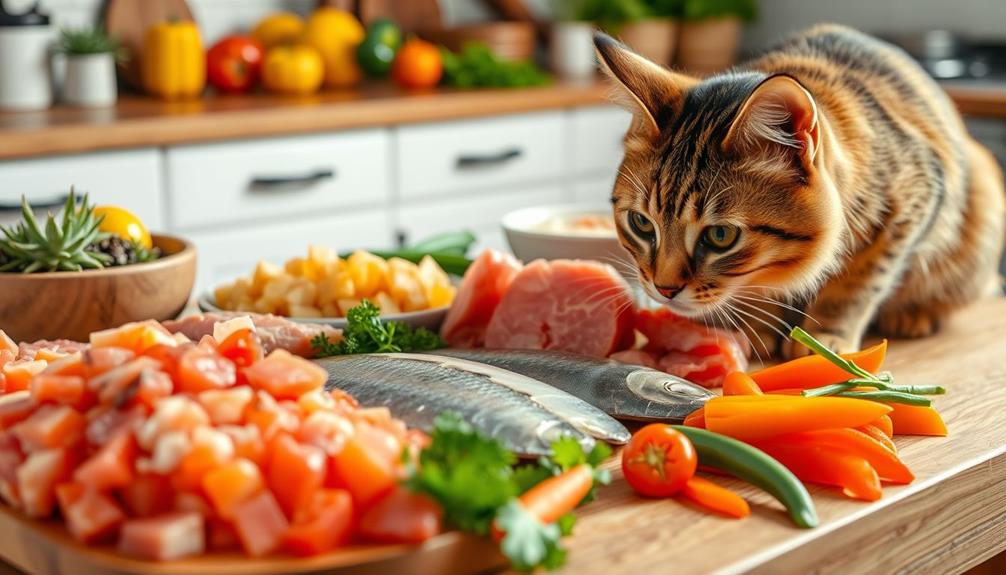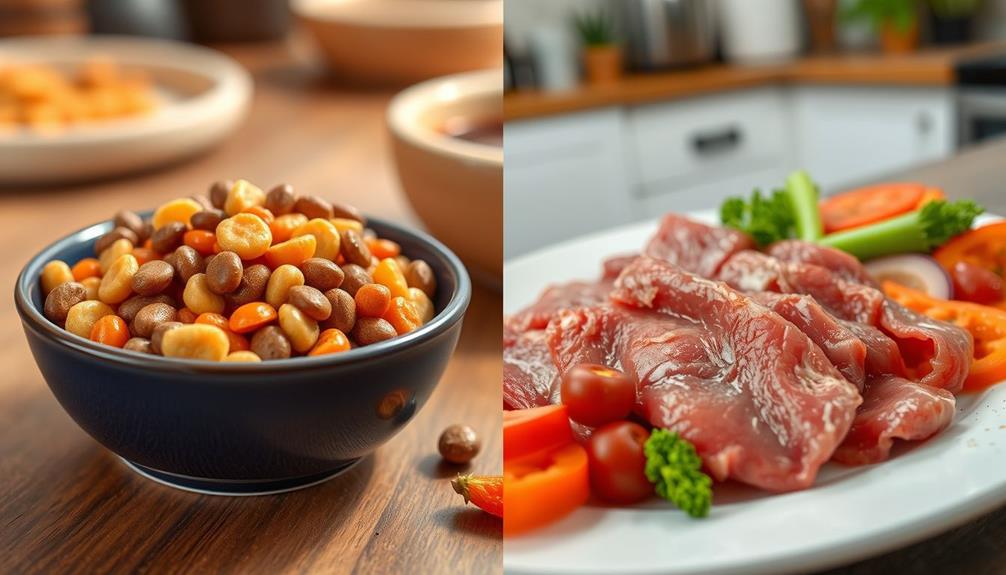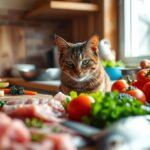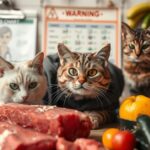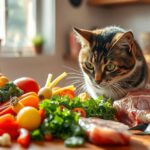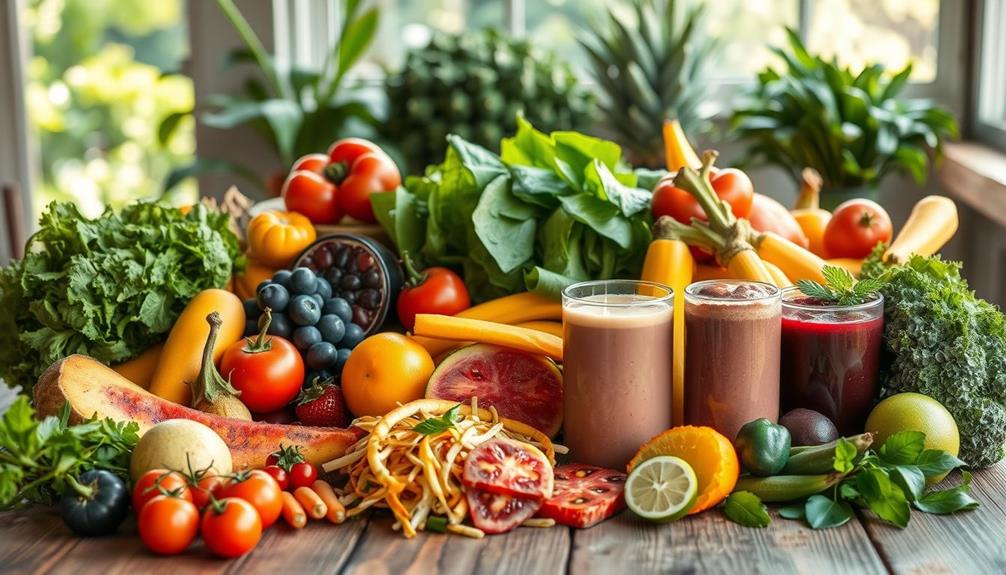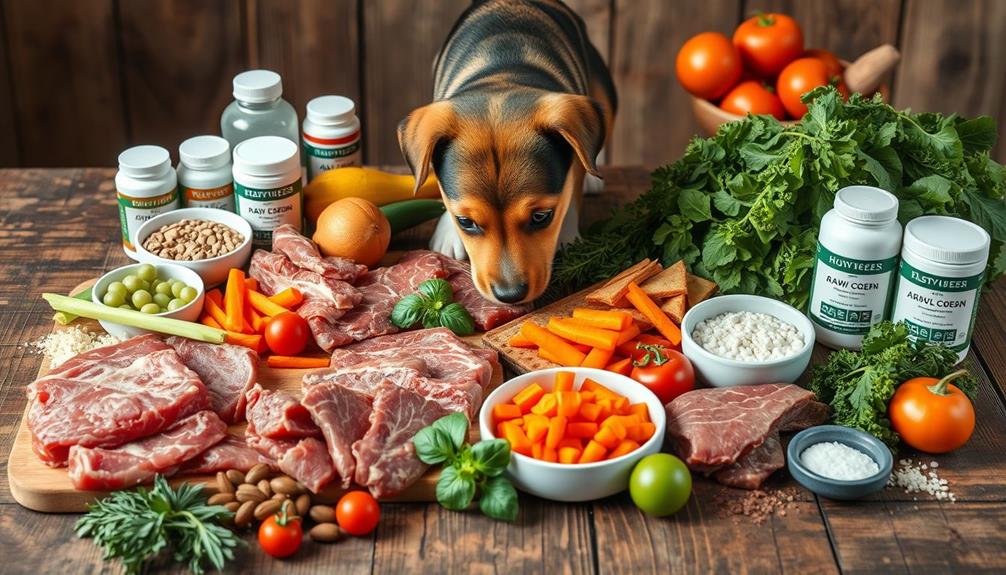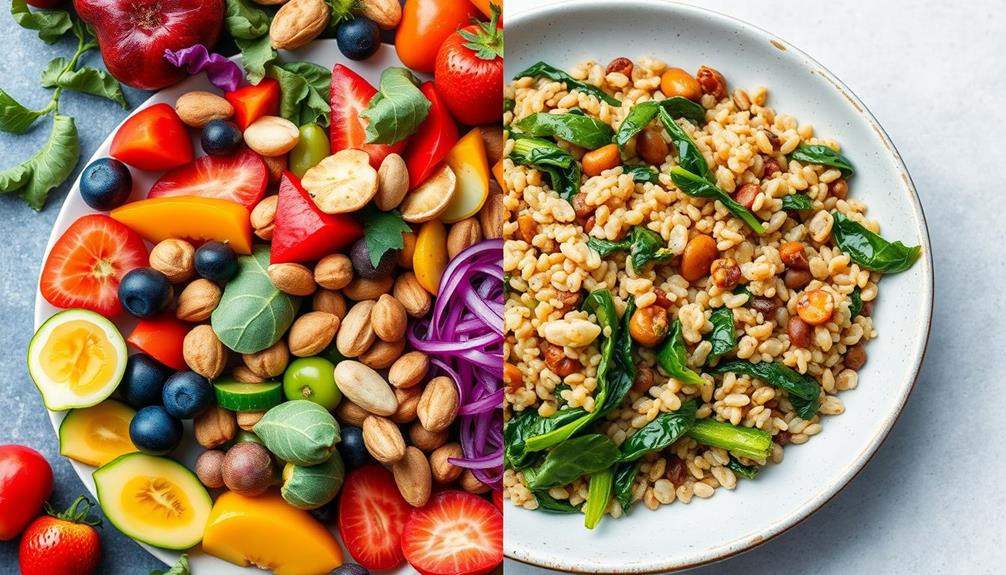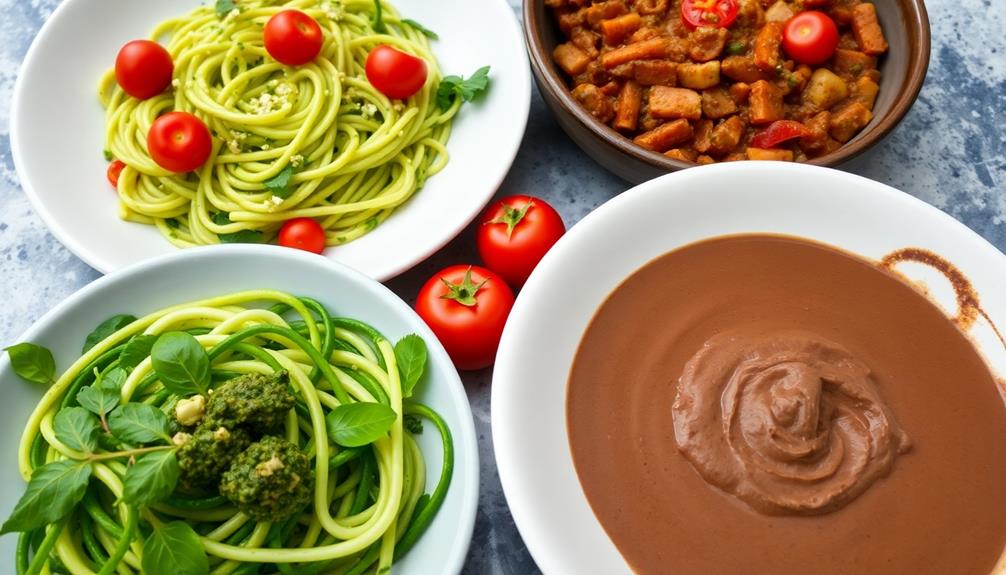Raw food can be beneficial for your cat due to its high protein content and essential nutrients like taurine. However, you should be cautious, as many raw diets may not provide balanced nutrition and can carry harmful bacteria, posing health risks to both your pet and your household. While homemade raw diets offer control over ingredients, they often lack essential nutrients. Commercial raw foods are more convenient but still require careful evaluation for safety. Consulting a veterinary nutritionist guarantees your cat's diet meets their needs. There's more to take into account about raw feeding that might surprise you, so keep exploring!
Key Takeaways
- Raw food diets can provide high protein levels and essential nutrients, but many lack balanced macro- and micro-nutrients.
- Approximately 25% of raw cat food samples test positive for harmful bacteria like Salmonella and E. coli, posing health risks.
- Homemade raw diets often fail to meet AAFCO nutrient profiles, leading to potential deficiencies and health issues.
- Veterinary experts generally advise against raw feeding due to significant safety concerns, especially for vulnerable households.
- High-quality commercial cat foods are considered safer and nutritionally complete, making them a preferred option.
Understanding Raw Cat Food
When evaluating a raw diet for your cat, it's essential to understand what it entails. Raw cat food mainly consists of unprocessed ingredients like uncooked meat, fish, and internal organs, along with ground bone to provide necessary calcium and phosphorus.
Cats require a high-protein diet, and a raw diet must meet their specific nutritional needs, including important nutrients such as taurine, arachidonic acid, and various vitamins. Additionally, just as individuals with mental health disorders like BPD may face unique dietary and lifestyle challenges, it's important to reflect on your cat's overall health and needs when shifting to a raw diet.
You'll find two primary types of raw cat food: homemade and commercial. Homemade diets give you control over ingredients but require careful balancing to guarantee nutritional adequacy.
On the other hand, commercial options, often available as frozen or freeze-dried products, can simplify the process but may vary in quality.
It's important to note that nutritional adequacy in raw diets can differ greatly. Consulting with a veterinary nutritionist is essential to make sure your cat receives all the necessary vitamins and minerals.
While raw feeding may seem appealing, be aware of the risks, including potential bacterial contamination and nutritional imbalances, that major health organizations caution against. Balancing these factors is critical before making the switch to a raw diet.
Nutritional Benefits and Risks
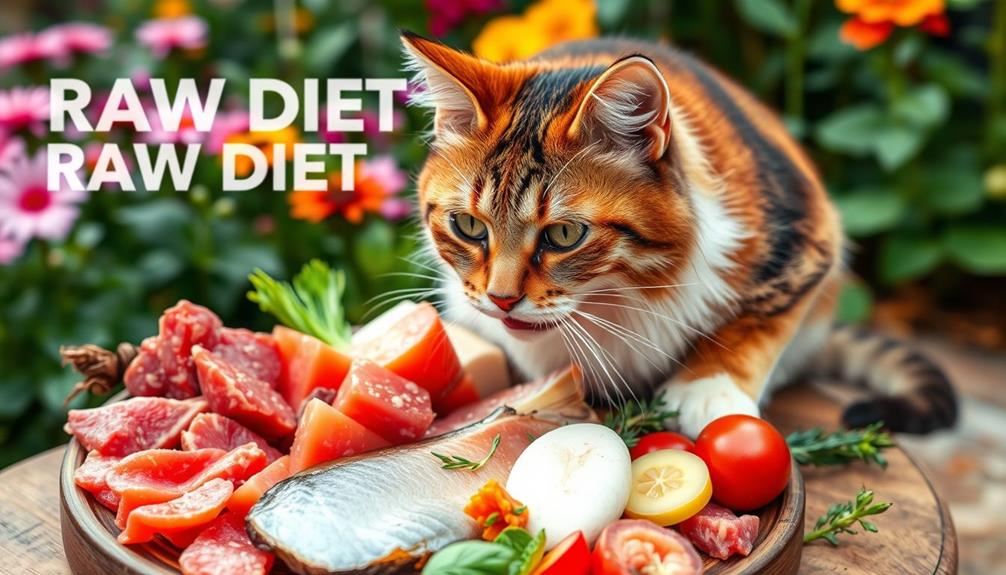
Exploring the nutritional benefits and risks of a raw food diet for your cat reveals a complex landscape. On one hand, raw diets can offer high protein levels and vital nutrients like taurine and arachidonic acid, which are important for your cat's health as an obligate carnivore.
Creating a Personal Budget involves setting specific targets, similar to how a balanced diet should meet your cat's unique nutritional needs. However, these diets often fall short in providing balanced macro- and micro-nutrients. Research shows that nearly 25% of commercially available raw diets test positive for harmful bacteria, posing significant health risks not only to your cat but also to you.
Homemade raw diets frequently lack the recommended AAFCO nutrient profiles, leading to potential deficiencies and health risks if they're not formulated by veterinary nutritionists. Without sufficient scientific evidence to support the superiority of raw diets over conventional prepared foods, concerns about their overall nutritional adequacy and safety persist.
Before deciding to switch your cat to a raw food diet, it's vital to weigh these nutritional benefits against the possible health risks. Consulting with your veterinarian can help guarantee that your cat's nutritional needs are met while minimizing potential hazards associated with raw feeding.
Safety and Handling Precautions
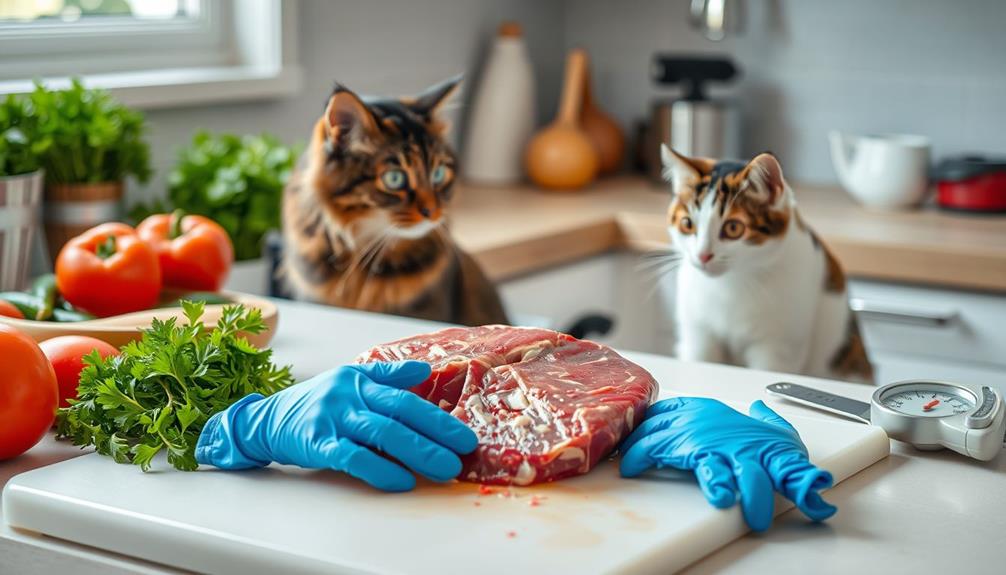
Switching to a raw food diet for your cat brings important safety and handling considerations. Raw pet foods can be contaminated with Salmonella and E. coli, with estimates suggesting that 25% of raw chicken parts are affected. To guarantee your safety and your cat's wellbeing, it's vital to follow strict safety and handling precautions, especially if you're also considering natural remedies alongside conventional medications.
Always wash your hands thoroughly after handling raw food. Clean and disinfect all surfaces and utensils that come in contact with raw meat to prevent cross-contamination.
Store raw meat products in the freezer until you're ready to use them, and never rinse raw meat, as this can spread harmful bacteria.
Freezing raw meat for 24 hours to 7 days can help eliminate most parasites, but it's important to maintain safe food-handling practices throughout. Keep raw food separate from other food items to minimize the risk of contamination.
If you're concerned about bacteria, consider high-pressure processing (HPP) options, which greatly reduce bacterial counts while preserving the food's nutritional integrity.
Homemade Vs. Commercial Raw Food
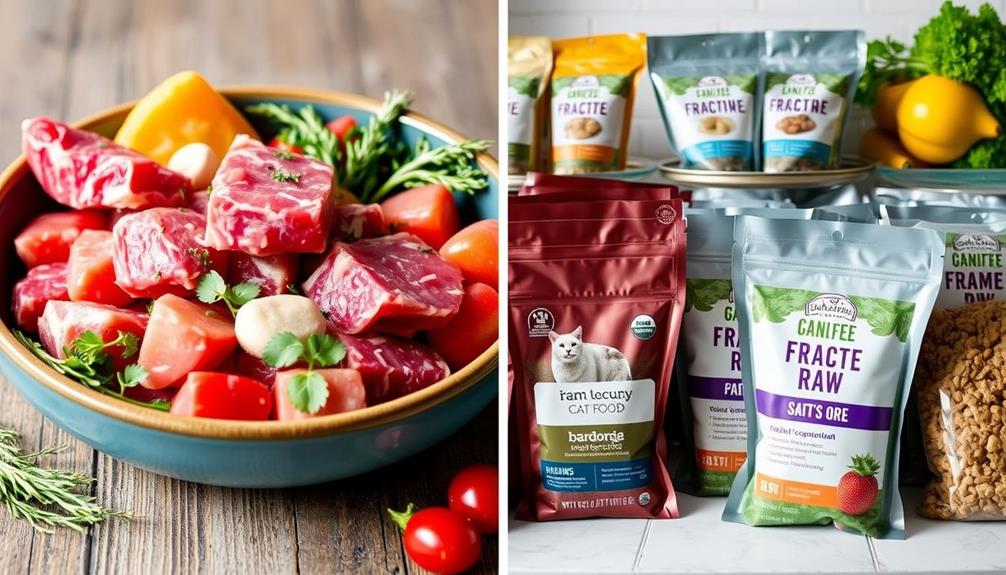
When choosing between homemade and commercial raw food for your cat, consider the nutritional balance each option offers.
Homemade diets give you control over ingredients, but they often require more time and expertise to guarantee they're complete and safe. Additionally, it's important to monitor for any signs of illness or nutritional deficiencies, as improper diets can affect health, similar to the way routine health checks for signs of illness or injury recommended for hamsters.
On the other hand, commercial options can save you time but may come with contamination risks, so it's essential to weigh the costs and preparation involved.
Nutritional Balance Considerations
Nutritional balance is vital for a cat's health, and the choice between homemade and commercial raw food diets can greatly impact this. When considering what to feed your cat, it's important to evaluate the nutritional quality of each option.
Additionally, understanding the significance of a balanced diet can help prevent common financial mistakes associated with pet care, such as overspending on unverified food products. When budgeting for your pet's nutrition, consider budgeting for pet care as part of your overall financial planning.
1. Homemade Diets: These must be carefully formulated to provide all essential vitamins and minerals.
Unfortunately, a study revealed that only one out of hundreds of homemade diets was close to achieving a balanced diet, which highlights the risks of poorly planned meals.
2. Commercial Options: Many commercial raw food products come with premixes that include the necessary vitamins and minerals.
This can often offer a more nutritionally complete alternative compared to homemade diets, which may lack proper guidance.
3. Consultation: It's advisable to consult with a veterinary nutritionist when considering either diet.
Their expertise guarantees that your cat's nutritional needs are met adequately, minimizing health risks.
Safety and Contamination Risks
Although feeding your cat a raw food diet can be appealing, it's important to understand the safety and contamination risks involved with both homemade and commercial options. Studies show that about 25% of raw food samples harbor dangerous bacteria, like Salmonella and E. coli, which can pose serious health threats to both your cat and your household.
Additionally, it's significant to consult with your veterinarian about mammography guidelines to guarantee your cat's diet is safe and appropriate for their individual health needs.
Homemade raw diets often lack nutritional balance and may unknowingly include toxic ingredients if not properly formulated by a veterinary nutritionist. This can elevate health risks for your cat.
On the other hand, while commercial raw diets offer convenience, they still require careful handling to minimize contamination. Proper storage, hygiene practices during preparation, and thorough handwashing are crucial in reducing the likelihood of foodborne illness.
Organizations like the CDC and FDA caution against raw feeding, especially for households with vulnerable individuals, such as children or those who are immunocompromised.
Following safe handling guidelines and making sure your cat's diet is balanced can help mitigate these risks. By being aware of these safety and contamination issues, you can make a more informed decision about incorporating raw food diets into your cat's meals.
Cost and Preparation Time
Feeding your cat a raw food diet can come with significant differences in cost and preparation time, depending on whether you choose homemade or commercial options. Here's what you need to take into account:
1. Cost: Homemade raw food often requires a higher upfront investment in quality meats and supplements. In contrast, commercially available raw cat food typically costs between $2 to $5 per meal, making it more predictable and easier to budget.
Additionally, using ingredients like butter in cooking may enhance flavor, but it's important to verify they're suitable for feline diets.
2. Preparation Time: Preparing homemade raw meals can be time-consuming, especially when balancing nutrients.
Alternatively, commercial options save you time since they're pre-formulated for nutritional adequacy and ready to serve.
3. Long-Term Commitment: While homemade diets allow for ingredient control, they often necessitate veterinary consultations to prevent nutritional imbalances, adding to both cost and preparation time.
Pre-portioning homemade meals can help streamline your routine, but ongoing shopping for commercial options might become tedious.
Ultimately, the choice between homemade and commercially available raw cat food depends on your budget and how much time you can dedicate to preparation.
Evaluate your cat's needs and your lifestyle before deciding.
Comparing Raw and Cooked Diets
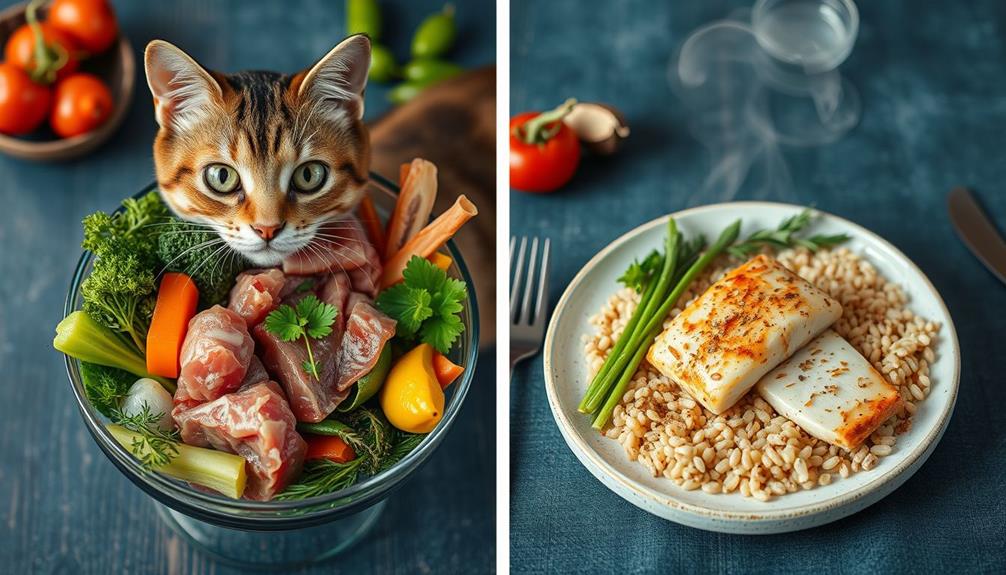
When you're weighing the benefits of raw versus cooked diets for your cat, it's vital to take into account nutritional balance, safety, and the potential risks of contamination.
While raw diets may pack in more bioavailable nutrients, cooking can enhance food safety by eliminating harmful bacteria.
Additionally, incorporating natural remedies such as essential oils can support overall health, as seen with essential oils for respiratory health.
Understanding these factors will help you make an informed choice that best supports your cat's health.
Nutritional Balance Comparison
Many cat owners wonder about the nutritional balance of raw versus cooked diets for their pets. While raw food diets can seem appealing, they often lack the carefully balanced nutrition cats need.
Understanding costs associated with assisted living is essential, just as ensuring that a cat's diet meets its nutritional requirements is important for its health. Here's a comparison to reflect upon:
- Nutritional Integrity: Many homemade raw diets fail to provide essential vitamins and minerals, risking deficiencies in your cat's health. AAFCO nutrient profiles must be met, which isn't always achievable with raw diets.
- Safety and Balance: Expert-formulated cooked diets generally offer a complete and balanced nutritional profile, ensuring your cat gets everything they need without the harmful bacteria that raw diets may harbor.
- Digestibility and Hydration: Cooked foods enhance digestibility and hydration, making it easier for your cat to absorb nutrients. High-quality processed options can rival raw diets in nutritional benefits while being safer.
Safety and Contamination Risks
Raw diets can pose significant safety and contamination risks that every cat owner should consider. Studies show that about 25% of tested raw food samples contain harmful bacteria such as Salmonella and E. coli. These bacteria not only endanger your cat's health but also pose a risk to humans, as the CDC estimates around 1.2 million annual cases of salmonellosis in people.
Cats can carry Salmonella without showing symptoms, increasing the chance of transmission within your home. Additionally, it's essential to recognize that cats should generally avoid ice cream, as dairy can upset their stomachs, further complicating their dietary needs pet-friendly ice creams.
While high-quality raw diets might seem appealing, they can still harbor parasites. Although freezing raw meat for 24 hours to 7 days can kill most parasites, you need to follow strict hygiene practices to prevent illness.
Veterinarians have pointed out that raw feeding raises the risk of zoonotic infections, especially in households with vulnerable individuals, making it vital to weigh these risks.
In contrast, cooking pet food effectively eliminates harmful bacteria, enhancing overall safety and nutritional value. By opting for cooked diets, you can provide a safer, more reliable option for your cat's health while minimizing contamination risks for your family.
Cooking Benefits for Pets
A well-cooked diet offers numerous benefits for your cat, particularly regarding safety and nutrition. When you choose high-quality cooked food, you're not just feeding your pet; you're also promoting their overall health.
Cooking food can also reduce the potential for harmful substances, as seen with certain raw ingredients that may lead to gastrointestinal issues. Here are three key advantages of a cooked diet:
- Reduced Risk of Foodborne Illnesses: Cooking eliminates harmful bacteria and parasites, greatly lowering the chances of foodborne illnesses like Salmonella and E. coli, which can affect both pets and humans in the household.
- Nutrient Retention: High-quality cooked diets can retain essential nutrients and meet AAFCO standards, ensuring your cat gets the necessary vitamins and minerals for peak health. This is particularly important as some raw diets may not provide balanced nutrition, leading to deficiencies nutrient deficiencies.
- Enhanced Digestibility: Cooking improves the digestibility of specific ingredients, leading to better nutrient absorption. This can contribute to noticeable improvements in your cat's coat condition and energy levels.
Expert Recommendations and Resources
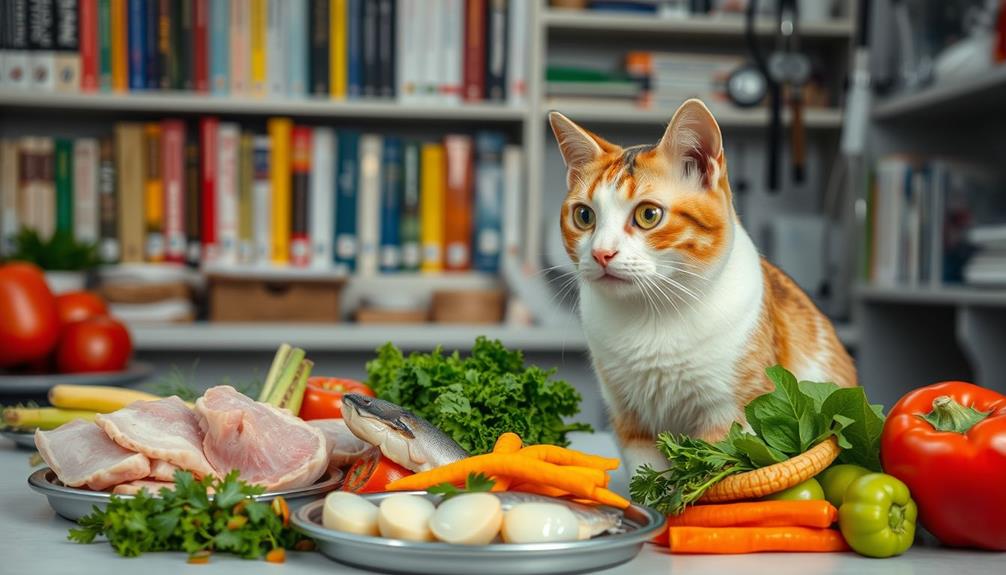
Veterinary experts consistently advise against feeding cats raw food due to significant health risks. Major health organizations like the CDC and FDA highlight that raw pet food often carries harmful bacteria, with studies showing nearly 25% of samples testing positive for pathogens like Salmonella and E. coli.
These risks are particularly concerning for households with children or immunocompromised individuals. Additionally, understanding the financial implications of pet care can help pet owners make informed decisions about nutrition and overall health care, including financial considerations for elderly care.
If you're considering homemade cat food, it's essential to consult a veterinary nutritionist. They can provide expert recommendations to guarantee your cat receives a balanced diet that meets all essential nutrient requirements.
Many homemade and commercial raw diets fail to comply with AAFCO standards for complete nutrition, potentially leading to severe health issues.
Instead of raw diets, consider high-quality, commercially prepared cat foods. These products are generally safer and nutritionally complete, providing your feline friend with everything they need without the associated health risks.
If you still want to explore raw feeding, doing so under the guidance of a veterinary nutritionist can help mitigate risks and guarantee your cat's health remains a priority.
Ultimately, the safest approach for your cat's nutrition is one that aligns with expert advice.
Frequently Asked Questions
Is Raw Food Actually Good for Cats?
Raw food diets for cats might sound appealing, but they carry significant health risks. You could face bacterial contamination and nutritional imbalances, so it's essential to consult your vet before making any drastic dietary changes. Additionally, many raw food diets for cats do not provide the necessary vitamins and minerals that are essential for feline health. Without proper supplementation, cats can suffer from deficiencies that can lead to serious health issues. It’s important to discuss the question ‘can cats eat raw food‘ with a professional to ensure that your feline friend receives a balanced and nutritious diet.
Do Vets Recommend a Raw Diet for Cats?
Most vets don't recommend a raw diet for cats due to risks like bacterial contamination and nutritional imbalances. They emphasize safer, nutritionally complete diets to keep your feline healthy and thriving.
Do Cats Live Longer on a Raw Diet?
Imagine a tightrope walker balancing on a thin line; while some claim cats thrive on raw diets, scientific evidence suggests they don't necessarily live longer. Balanced commercial diets often provide better nutrition and overall health benefits.
Is It Better to Feed Cats Raw or Cooked Meat?
When deciding whether to feed your cat raw or cooked meat, consider that both options can meet their nutritional needs. It's essential to balance the benefits and risks, ensuring proper sourcing and handling for safety.
Conclusion
In summary, raw food can be a nutritious option for your cat, but it comes with its own set of risks. Did you know that a study found that nearly 70% of cat owners who switch to a raw diet report improved energy levels in their pets? It's essential to weigh the benefits against the potential hazards, and always consult your vet before making any drastic changes. Your cat's health and happiness are worth the effort!

